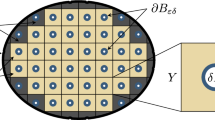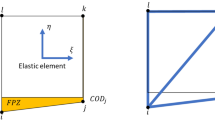Abstract
This paper and its companion are devoted to the study of crack kinking from some small pre-existing crack originating from a notch root (the notch root radius being zero). Both the notch boundaries and the initial crack are allowed to be curved; also, the geometry of the body and the loading are totally arbitrary. The ingredients required are knowledge of the stress intensity factors at the initial crack tip and use of a suitable mixed mode propagation criterion. This paper is devoted to the first point, and more specifically to establishing the general (that is, not yet fully explicit) form of the formulae giving these stress intensity factors. The method used is based on changes of scale (homogeneity properties of the equations of elasticity) on the one hand, and on continuity of the displacement and stresses at a given, fixed point with respect to the crack length on the other hand. The formulae derived for the stress intensity factors at the tip of the small crack are of universal value: they apply to any situation, whatever the geometry of the body, the notch and the crack and whatever the loading, the stress intensity factors depending always only upon the `stress intensity factor of the notch' (the multiplicative coefficient of the singular stress field near the notch root in the absence of the crack), the length of the crack, the aperture angle of the notch and the angle between its bisecting line and the direction of the crack.
Similar content being viewed by others
References
Aliabadi, M.H., Rooke, D.P. and Cartwright, D.J. (1987). Mixed-mode Bueckner weight functions using boundary element analysis, International Journal of Fracture 34, 131-147.
Amestoy, M., Bui, H.D. and Dang Van, K. (1979). Déviation infinitésimale d'une fissure dans une direction arbitraire. Comptes-Rendus de l'Académie des Sciences de Paris 289B, 99-102.
Amestoy, M. and Leblond, J.-B. (1992). Crack paths in plane situations-II. Detailed form of the expansion of the stress intensity factors. International Journal of Solids and Structures 29, 465-501.
Bilby, B.A. and Cardew, G.E. (1975). The crack with a kinked tip. International Journal of Fracture 11, 708-712.
Fett, T. and Munz, D. (1997). Stress Intensity Factors and Weight Functions, Computational Mechanics Publications, Southampton, UK.
Goldstein, R.V. and Salganik, R.L. (1974). Brittle fracture of solids with arbitrary cracks. International Journal of Fracture 10, 507-523.
Gross, B. (1970). Some Plane Problem Elastostatic Solutions for Plates Having a V-Notch, Ph.D. Thesis, Case Western Reserve University, USA.
Hasebe, N. and Iida, J. (1978). A crack originating from a triangular notch on rim of a semi-infinite plate. Engineering Fracture Mechanics 10, 773–782.
Isida, M. (1979). Tension of a half-plane containing array cracks, branched cracks and cracks emanating from sharp notches. Transactions of the Japan Society of Mechanical Engineers 45, 306–317.
Leblond, J.-B. (1989). Crack paths in two-dimensional situations-I. General form of the expansion of the stress intensity factors. International Journal of Solids and Structures 25, 1311–1325.
Muskhelishvili, N.I. (1952). Some Basic Problems of the Mathematical Theory of Elasticity, Noordhoff, Leiden, the Netherlands.
Sha, G.T and Yang, C.T. (1985). Weight function calculations for mixed-mode fracture problems with the virtual crack extension technique. Engineering Fracture Mechanics 21, 1119–1149.
Williams, M.L. (1952). Stress singularities resulting from various boundary conditions in angular corners of plates in extension. Transactions of the American Society of Mechanical Engineers. Journal of Applied Mechanics 19, 526–528.
Wilson, W.K. (1969). On Combined Mode Fracture Mechanics, Research Report 69-1E7 FMECH-R1, Westinghouse Research Laboratories, Pittsburgh, USA.
Wu, C.H. (1978). Elasticity problems of a slender Z-crack. Journal of Elasticity 8, 183–205.
Author information
Authors and Affiliations
Rights and permissions
About this article
Cite this article
Leblond, JB., Mouro, P. Crack propagation from a pre-existing flaw at a notch root. I. Introduction and general form of the stress intensity factors at the initial crack tip. International Journal of Fracture 104, 209–222 (2000). https://doi.org/10.1023/A:1007684632479
Issue Date:
DOI: https://doi.org/10.1023/A:1007684632479




